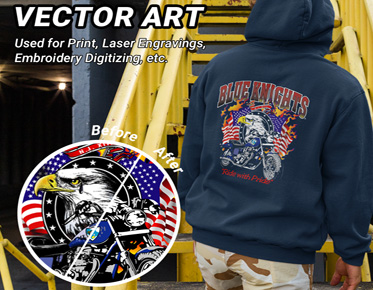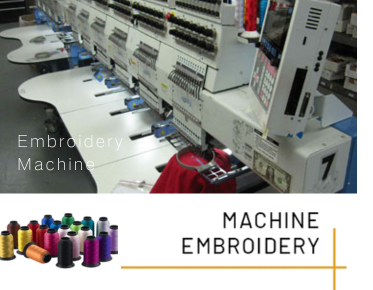Myth: Vectors Can’t Handle Detailed Illustrations
Debunking the Myth: Why Vectors Aren’t Just for Simple Shapes
There's a widespread misconception in the design world that vector graphics are only suited for clean, simple designs—shapes, logos, icons, and other minimalistic visuals. While this notion might have had some truth in the early days of vector art, it's far from the reality today. Vectors have evolved into a powerhouse for creating highly detailed and intricate designs that rival any raster-based artwork. From detailed illustrations to complex textures, vectors can handle the most challenging of artistic tasks. This article explores how vectors can carry complexity, precision, and depth while maintaining their unique advantages over raster graphics. Let’s dive into how these designs work and break the myth wide open.
Understanding Vector Graphics vs. Raster Graphics: A Quick Breakdown
To truly appreciate the power of vector graphics, it’s essential to understand how they differ from raster graphics. Raster graphics, such as photographs, are made up of pixels. This means that when you scale them up, you lose quality, and the image becomes pixelated and blurry. On the other hand, vector graphics are created using mathematical equations that define shapes and paths, making them infinitely scalable. No matter how much you enlarge a vector, it will remain sharp and crisp, preserving its original integrity. The key advantage here is that vectors don’t rely on the finite grid of pixels, meaning they can be stretched and manipulated without fear of losing resolution. This inherent scalability is one of the key reasons vectors are so ideal for detailed designs—they can grow in complexity without losing clarity. In contrast, raster-based designs are often constrained by the original resolution and can require more memory when dealing with larger images.
The Power of Vectors: Unlocking Infinite Detail Potential
Vector art is not limited to basic shapes and flat colors. Thanks to sophisticated algorithms and design tools, vectors can be manipulated to create designs that are intricate and detailed, whether you're working with geometric patterns, intricate line art, or textures. The true power of vectors lies in their flexibility to stretch the bounds of imagination without compromising the quality of the design. Unlike raster images that lose fidelity when resized, vector designs retain perfect resolution even when scaled up to enormous sizes. This ability to infinitely scale designs means that artists can create artwork as detailed as they desire, all while maintaining absolute sharpness. Moreover, this potential for infinite detail gives designers the creative freedom to experiment with precision and exploration. Whether you’re designing for print, web, or animation, vectors give you complete control over every aspect of your design.
What Makes Vectors So Special? The Magic Behind Scalable Design
Vectors are built on paths, defined by anchor points that form the foundation of any shape or line. This mathematical approach allows for scalability, meaning the design won’t distort or lose sharpness at any size. The beauty of vectors is that they’re not reliant on pixels—each curve, line, and color gradient is calculated and represented by precise geometric formulas. These paths make it easy to adjust shapes, manipulate details, and create designs that breathe life. Whether you're designing something as simple as a logo or as complex as a highly detailed portrait, vectors offer a unique combination of precision, flexibility, and scalability that raster graphics simply can't match. The entire design process becomes a matter of adjustments made in a digital space without ever sacrificing quality. The deeper you explore vectors, the more their potential to create fluid, organic designs becomes clear—whether that’s in creating soft, flowing curves or sharp, intricate edges.
The Role of Anchor Points and Paths in Handling Complexity
At the heart of every vector graphic lies the anchor point. These are the building blocks of a vector image, allowing designers to control the placement, direction, and curvature of every path. With enough anchor points, even the most complex forms and illustrations can be crafted with impeccable precision. When working with detailed vector designs, every curve and angle can be manipulated to perfection, ensuring the illustration matches the artist's vision. By adjusting paths and anchor points, designers can create sweeping lines, delicate curves, or sharp angles that are both accurate and expressive. This level of control over the shape and flow of every segment is what allows vector designs to evolve into works of art that are both detailed and structurally sound. Additionally, the precision offered by anchor points allows for consistent results, even when the design is scaled or altered across different formats.
Detailed Doesn’t Mean Impossible: How Vectors Excel at Precision
One of the key advantages of vector art is its ability to achieve a level of precision that other mediums can’t always replicate. Because vectors are created with mathematical formulas, they allow designers to control every aspect of the design with accuracy. When crafting highly detailed illustrations, this precision becomes indispensable. Whether you’re building a landscape with intricate textures or rendering a portrait with fine linework, vectors allow every detail to be placed with accuracy. The fine lines remain sharp, the edges crisp, and the transitions smooth, giving designers the ability to handle complexity without compromising clarity. Moreover, vectors offer a consistent approach, which means that each design element, no matter how intricate, will always remain in perfect alignment. This allows for the creation of highly detailed, yet perfectly organized artwork that can easily be manipulated or altered during the design process.
Achieving Fine Details in Vectors Without Losing Quality
The hallmark of vector art is its scalability, and this scalability is what allows for fine detail work without sacrificing quality. Unlike raster images that can become blurry or pixelated when enlarged, vectors maintain their sharpness and clarity at any size. This makes vectors the ideal choice for projects that demand high detail, such as product illustrations, technical drawings, or even detailed character designs. Thanks to the nature of vectors, details like thin lines, delicate gradients, and subtle textures are preserved in all their glory, ensuring your design remains pristine regardless of its scale. The ability to scale these designs is especially valuable for large-scale applications, such as billboards or posters, where minute details must remain crisp even when viewed from afar. With vectors, you never need to worry about compromising quality as your design evolves.
How Vectors Handle Gradients and Shadows Like a Pro
Vector graphics are not just about sharp lines and solid fills—they can also handle gradients and shadows with remarkable precision. By using gradient meshes or vector-based brushes, designers can create smooth transitions of color, from soft fades to bold shifts. Vectors allow these transitions to remain smooth and flawless, making it possible to create lifelike depth and dimension. Shadows can be crafted using layered vector shapes, resulting in subtle, realistic effects that add richness to the design. The key here is that vectors handle these nuances without the loss of resolution, making them a perfect tool for highly detailed, professional-quality artwork. With the right tools and techniques, vectors can imitate traditional painting methods while preserving the sharpness and cleanliness that define their digital nature. Furthermore, with advanced gradient tools, even the most intricate and layered color shifts can be achieved, enhancing the overall realism of the vector design.
From Intricate Line Work to Realistic Textures: Exploring the Possibilities
While vectors are known for their clean, crisp lines, they also can handle highly detailed and textured work. Intricate line work can be achieved by manipulating anchor points to create fine, controlled curves. Additionally, textures that replicate traditional brushstrokes or more organic materials can be mimicked in vector art, thanks to the flexibility of vector-based brushes and tools. Realistic textures, from the soft fuzz of a fabric to the rough grain of wood, can be illustrated with vector paths and gradients, bringing the design to life. Vectors have evolved from basic shapes to powerful tools capable of translating even the most textured, layered illustrations. This versatility also extends to producing three-dimensional effects, where designers can use a mix of textures and gradients to create an illusion of depth and realism. With vectors, the possibility to create incredibly diverse styles, from hyper-realistic to abstract, has opened new doors for artists.
How Vectors Can Create Stunning Illustrations with Complex Details
Whether you’re designing a realistic portrait, a detailed landscape, or a complex pattern, vectors are up to the task. Their ability to handle complex details is unparalleled, enabling designers to work with multiple layers, intricate linework, and gradients without losing the integrity of the design. Vectors are capable of producing illustrations with multiple elements that fit together seamlessly, creating a cohesive and detailed artwork that is crisp and precise. Whether you're adding highlights to a character's face or rendering a cityscape with hundreds of buildings, vectors allow you to work at a granular level while maintaining the overall harmony of the piece. Additionally, their scalability means that every detail, no matter how small, will remain sharp and impactful even at large sizes. This makes vectors a perfect choice for artwork that requires intricate detailing and a high degree of precision, such as architectural designs or fine art illustrations.
Using Multiple Layers to Build Depth and Intricacy in Vector Art
Layering is a fundamental technique in vector art that adds depth, dimension, and complexity. Just like in traditional painting or digital illustration, vector designers can work in layers, stacking elements on top of one another to create a sense of space. By layering colors, gradients, and shadows, artists can create the illusion of depth, turning flat designs into intricate, multifaceted visuals. This layering technique allows for easy adjustments, as designers can work on specific elements without disturbing the entire artwork. The result is a balanced, detailed, and visually rich piece that doesn’t lose its crispness. Furthermore, this layered approach enables designers to tweak or enhance individual elements without disrupting the overall design, giving them a high degree of flexibility during the creative process. It’s a technique that makes vector designs versatile, especially when tackling highly detailed compositions.
Mastering the Tools: Software That Lets You Push Vectors to Their Limits
To create complex, detailed vector artwork, you need the right tools. Programs like Adobe Illustrator, Affinity Designer, and CorelDRAW provide an array of powerful tools to craft intricate designs. These tools give you control over every anchor point, every path, and every color. Illustrator, for example, offers advanced features like the Pen Tool, Shape Builder, and Gradient Mesh, which enable you to create detailed designs with ease. Affinity Designer and other programs also offer similar capabilities, with some even providing more intuitive workflows for intricate designs. The right software allows you to push vector art beyond the basic shapes, turning it into a versatile tool for professional-grade illustrations. These tools are essential for achieving the full potential of vector art and are indispensable for designers looking to create finely detailed projects with precision.
Illustrator, Affinity Designer, and More: The Best Programs for Detailed Vectors
Adobe Illustrator has long been the industry standard for vector illustration. It’s packed with tools that allow you to create anything from intricate linework to rich, detailed textures. Affinity Designer, a popular alternative, offers an intuitive interface and powerful tools, making it an excellent choice for vector artists at all levels. Other programs like CorelDRAW and Inkscape also provide professional-grade features for creating detailed vector art conversion. The key to mastering these programs lies in understanding their unique toolsets and learning how to apply them to your designs. With the right program, vector illustration is limited only by your imagination. These programs have built-in tools and features that allow users to focus on the finer aspects of their work, ensuring precision and offering flexibility when tackling intricate projects.


